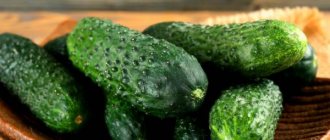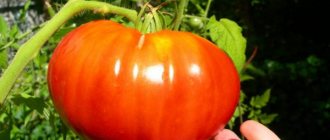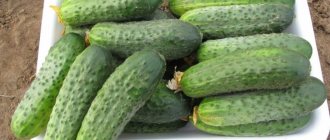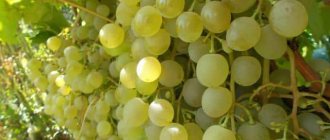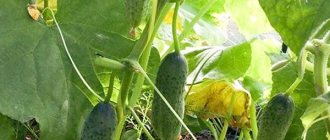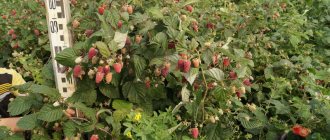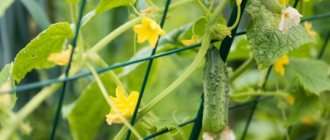It is difficult to imagine a housewife who would not allocate at least a small piece of her garden for cucumbers. More often they occupy a substantial area, freely spreading their lashes along the ground or raised on a trellis. If there is a greenhouse on the site, then its indispensable inhabitants will be the same cucumbers. Cucumber Rodnichok f1 is a variety that we always return to after trying many new products. And although Rodnichok is a hybrid of an old, Soviet selection, even the most modern varieties cannot compete with it in terms of taste, yield and disease resistance.
Cucumber Rodnichok: characteristics and description of the variety
The cucumber hybrid fontanelle is mid-season in terms of ripening - almost 2 months pass from the moment the seed material germinates until the first ripe cucumbers are harvested. This vegetable crop is pollinated by bees
.
Although the harvest begins in the last ten days of June, the main yield of the Rodnichok cucumber occurs in August.
This variety can be grown both in garden beds and in greenhouse conditions.
. But in the greenhouse it is necessary to create conditions so that pollinating insects can fly there.
Photos of Rodnichok cucumbers
The lashes of this hybrid can grow up to 2.8-2.9 m in height, the side shoots grow weakly.
The foliage of the hybrid is a rich emerald color, medium in size, and in shape - typical of cucumber varieties.
Zelentsy grow up to 100-110 g
, longitudinal white stripes are clearly visible on the soft green skin. Small sparse black spikes are noticeable on the surface of the greens.
Interesting to know!
The best varieties of cucumbers for growing in open ground
One of the advantages of the variety is the excellent presentation of ripe cucumbers, which also have approximately the same size (no more than 10-11 cm). smooth cucumbers have a good taste, without bitterness, with a crunch. Lada, when overripe, the greens remain green for a long time.
Harvested cucumbers tolerate long-distance transportation well and can be stored for quite a long time in appropriate conditions.
Zelentsy are distinguished by their versatility - they are consumed fresh, added to salads, used for canning and pickling. Moreover, even with heat treatment, the cucumbers remain crispy and do not lose their taste.
Plant parameters
The Rodnichok variety can be easily recognized by the following parameters:
- Plant height is up to 3 meters.
- The fruit sizes are 10 - 12 cm in length.
- Fruit weight - 110 - 110 g.
- The shape of the fruit is cylindrical.
- Leaf size is medium.
- The leaf shape is heart-shaped.
- The leaves are light green in color.
The ovaries are formed in bunches, approximately 2 - 3 bunches per node. One plant can form 3 - 5 shoots. The light green fruits are covered with black spines and have white stripes on the side. When the fruit is cut, there are no voids inside. The flowers are dark yellow and large. The seeds are small, oval, white.
When growing, the lashes can be placed horizontally (on the ground) or vertically (on wooden supports, trellises).
Fruits of the Rodnichok variety
Growing cucumber requires compliance with agrotechnical rules. Vegetable growers carry out regular watering, apply fertilizers, remove weeds, and take preventive measures against diseases and pests. When the first symptoms are detected, folk or traditional remedies are used.
When buds appear, the crop is watered once every 2-3 days. The amount of water per square meter is increased by 5 liters. After flowering, ovaries are formed. During this period, plants are moistened every other day. After watering, the soil around the bushes is loosened and weeds are removed at the same time.
When the bushes have 3-4 leaves, the plants are fertilized with organic matter. Next, the cucumbers are fed every 15 days with complex fertilizers. For this purpose, special drugs are used, for example, “Good Power”. Fontana f1 responds well to nettle or yeast infusion. During the formation of ovaries, fertilizers with potassium and phosphorus are added.
When the crop begins to bear fruit, the plants are fed with an infusion of green grass or mineral fertilizers.
Advantages of cucumbers of the Rodnichok variety
The main positive qualities of the cucumber hybrid Rodnichok include:
- possibility of growing in beds and greenhouses;
- versatility of using the harvested crop;
- good taste, no bitterness
- high resistance to diseases and pest attacks;
- the possibility of long-term storage, during which the presentation does not deteriorate and the taste does not deteriorate;
- the possibility of growing for sale, since ripening greens have approximately the same size and good presentation.
According to vegetable growers, the Rodnichok cucumber has no disadvantages.
History of origin of the variety
The unpretentious hybrid owes its appearance to the team of the Pridnestrovian Research Institute and breeder Mashkov. The hardy and productive variety Rodnichok was bred in the 70s, and since then has been grown in Belarus, Poland, Slovakia, and Moldova. The hybrid was included in the Russian State Register in 1979 and is recommended for cultivation in the Urals, Caucasus, Volga region, Volga-Vyatka and Northern regions.
Planting and growing
Before planting the seed, you should select a site for planting this hybrid. Preference should be given to loose soils with a high content of fertilizers and neutral acidity. In addition, future beds should be well illuminated by the sun's rays throughout the daylight hours and be protected from gusts of the north wind.
Also, the site should not have close groundwater, otherwise it will be necessary to make high beds and also arrange a drainage layer.
The beds for planting are prepared in advance, in the fall. The area is dug up, adding compost, humus or mullein if necessary. Severely acidified soils require the addition of lime. In heavy soils, at least 5-6 kg of humus and the same amount of river sand should be added to each square of area.
Planting cucumber Rodnichok F1 - video
When purchasing seed material from well-known seed manufacturing companies, you will not have to disinfect it or carry out other preliminary work before planting, since all this has already been done before packaging the seeds in bags.
Since the Rodnichok cucumber is a hybrid, there is no point in leaving the seeds for further sowing - they will not retain their parental qualities.
Seeds can be planted using the square-cluster method according to a pattern of 0.3 * 0.3 m, if the cucumber vines are located on the soil, or at a distance of 0.15 m when grown on trellises
.
When growing this variety in regions with a cold climate, it is better to pre-plant the seeds for seedlings at home, and transplant the seedlings into open ground in late May - early June, when the spring cooling has passed.
When growing this vegetable crop in seedlings, you need to remember that these plants have a very delicate root system that does not tolerate unnecessary transplants. Therefore, cucumber seeds are planted immediately in separate cups or peat tablets.
When planting seed material directly into the beds, at least 2-3 seeds should be planted in each hole.
. The depth of their burial is no more than 2 cm. After planting, they are irrigated with settled warm water and covered with polyethylene to create a greenhouse effect.
Typically, seedlings appear quickly - on the third to fifth day after planting.
Choose good varieties of cucumbers:
Cucumber Maryina Roshcha F1 Cucumber True Friends F1 Cucumber variety Marinda F1
Features of growing seedlings
We recommend reading our other articles
- The most common diseases of cucumbers
- How to grow garden strawberries
- How many calories are in raspberries
- Pear variety Marble
Fruiting extended
Growing Rodnichok cucumbers can be done using seedlings or without seedlings. Seedlings are harvested in order to obtain a harvest 2 weeks earlier. Typically this method is used in the northern regions. If cucumbers are grown in the south, then the seeds can be sown directly into the ground, in a permanent place.
Important!
If the purchased seeds are covered with a bright shell, then you should not treat them before planting. Even simple soaking will do harm in this case!
Containers for seedlings should be at least 0.5 liters. And since these cucumbers do not pick, you should choose paper or peat cups. If the seeds are not treated, then they should be soaked for 20 minutes in warm water (+55 degrees Celsius) before sowing. To make them germinate faster, you can add Epin to the water.
To make them germinate faster, you can add “Epin” to the water.
Sowing cucumbers of the Rodnichok F1 variety into seedlings is carried out to a depth of 1 cm. 2-3 seeds are planted in one container. After sowing, the cups are covered with film and kept at a temperature of +25...+28 degrees Celsius. They need to be ventilated every day and sometimes sprayed with water. Seeds germinate in about 2-4 days. After the sprouts appear, the film is removed, and to prevent the seedlings from stretching, they are kept at a temperature of +15...+17 degrees and good lighting.
After 2 leaves appear, it is necessary to feed the seedlings with complex fertilizer. In this case, you need to leave only 1 plant in each pot and remove all the others. When the seedlings are 20-25 days old, they can be transplanted to a permanent place. This time usually falls between May 15 and June 5. If planting is carried out in a greenhouse, then this can be done earlier - May 10-20.
Important!
Overgrown seedlings do not take root well after transplanting to a permanent place, so this should not be delayed.
Further care for the Rodnichok cucumber
Further care for this vegetable crop consists of regular watering, carefully loosening the soil, removing weeds, applying fertilizer and tying canes to the trellises.
When watering, it is necessary to ensure that the top layer of soil is constantly moist. Cucumber beds should not be flooded, as excessive moisture can provoke the development of powdery mildew or fungal diseases, especially when growing cucumbers in greenhouse conditions. Water for irrigation should not be cold.
Prevention of diseases and pests
Although the Rodnichok variety is immune to rot, it is easier to prevent powdery mildew from infecting the plant with fungi or viruses than to treat it with chemicals later.
To prevent oversporosis, Rodnichok cucumber bushes are sprayed with potassium permanganate before planting in the garden; diseased plants are treated with Bordeaux mixture.
When white spots appear on the leaves, which signals infection with powdery mildew, the affected areas are torn off and burned, and the cucumbers are sprayed with manure and sprinkled with ground sulfur.
Root rot develops when the Rodnichka is irrigated with cold water, when there is a lack of minerals in the soil. To save cucumbers, bleach is scattered near the bushes, diseased roots are dug up and removed, and cut areas are disinfected with chalk and ash.
Anthracnose, in which the leaves of plants become covered with spots and a pinkish coating, is combated with the help of Bordeaux mixture.
To prevent the Rodnichok cucumbers from being affected by white rot, the beds are disinfected with potassium permanganate before planting, and a solution is added to the diseased plants, which is prepared by mixing 10 grams of urea and 2-3 g of copper sulfate in a bucket of water. To prevent cladosporiosis, cucumber bushes are treated with Bordeaux mixture.
Feeding cucumbers
Cucumbers require large amounts of potassium for active growth and fruit formation.
. Therefore, wood ash or mineral fertilizers with potassium salt are periodically added to the beds and row spacing.
During the summer season, you can feed the cucumbers a couple of times with mullein solution, which is prepared as follows:
1 kg of cow manure is diluted in 10 liters of water and infused for 12-13 days.
Then the resulting infusion is diluted with water in a ratio of 1:10 and the plants are fed.
How to grow your own
The time for sowing seeds in the ground or for seedlings depends on the method of cultivation (in open or closed ground conditions), the climate of the area, and the weather..
In central Russia, seed or seedlings are planted in an open garden bed in early June. Cucumber seedlings are planted in the greenhouse two weeks earlier.
Sowing seeds for seedlings is carried out two months before these dates (approximately at the beginning of May). The soil temperature for planting should be at least +16...+18 °C in protected or closed ground.
What are capers and what do they look like: properties and recipes, description of taste
In the southern regions, seeds are sown directly into the ground in early to mid-April. For this, the soil must warm up to at least +14 °C.
Important! Seeds are not planted before the onset of warm weather - the grains will simply die without sprouting.
If the weather is changeable, the seeds are planted at several times, but no later than mid-summer. Fruiting will be extended.
Planting by seedlings
To obtain an earlier harvest, cucumbers are grown in seedlings, but some vegetable growers plant the seeds directly in the beds.
Cucumber seedlings need fertile and neutral soil. Farmers purchase soil mixture at a gardening store or prepare it themselves by mixing humus, turf and manure in a ratio of 7:1:2.
Before planting, seed material is disinfected in a 1% solution of potassium permanganate (if the grains have not been treated by the manufacturer), then washed under running water.
Next, the seeds are germinated in damp cotton cloth until grain-sized sprouts appear. The gauze is periodically moistened, but the seeds are not allowed to float in the water. This procedure is carried out to ensure the germination of seeds and to obtain early shoots.
When the grains hatch, they are planted in individual containers of 1-2 seeds to a depth of 1.5-2 cm. After some time, the weak sprout is removed. A container for growing seedlings should be at least 0.4-0.5 liters in volume. It will grow in it until planting. Picking is not recommended.
The container with the crops is placed in a warm place with an air temperature of +20...+25 °C and covered with film or transparent glass to create greenhouse conditions. When shoots appear, the container is moved to a cooler place with an air temperature of +20...+22 °C during the day, and at night +15...+16 °C. Water the seedlings in the morning with water at room temperature.
After 20-25 days, the plants are planted in a permanent place. Overgrown seedlings will take root less well in a new location. A week before planting, the plants are hardened off. To do this, the bushes are taken out onto the balcony or placed near an open window, but so that there is no draft.
Direct sowing into the ground
Choose a place for growing cucumbers that is sunny and windless. The site should be free of stagnant water in rainy weather, as this causes fungal diseases, which significantly reduces yield.
In hot southern regions, planting is allowed in partial shade. To cultivate cucumbers, follow the rules of crop rotation. Zelentsy are not grown repeatedly in the same place or after melons. Good predecessors are tomatoes, peas, potatoes and corn.
The soil for cucumbers should be light and nutritious . The soil is prepared in the fall or two weeks before planting. To do this, organic matter is added to it (turf, peat, compost, manure, humus). Wood ash and mineral fertilizers, such as Superphosphate, are also added to the soil.
On a note. To be sure, many vegetable growers disinfect the soil with a solution of copper sulfate (1 teaspoon per 10 liters of water).
Cucumber Rodnichok: reviews from those who planted
Nastena, 60 years old, Stavropol region: My husband and I grow cucumbers for further sale, so over a couple of decades we have tried a large number of varieties, but we still invariably return to the Rodnichok hybrid, since we believe that this particular variety has good productivity, and its fruits are tasty, smooth and without bitterness (which is important).
Olga, 30 years old, Belgorod region: I have recently grown the Rodnichok variety - somehow this variety had never caught my eye before. The first time I bought only one bag of seeds, which was enough for a small garden bed. The hybrid did not require any special care, but it was a pain to pick ripe cucumbers. I would like to note that the vines of this cucumber did not hurt, and with regular feeding, the yield only increased. I will continue to grow this variety and allocate more space for it, since its cucumbers are universal; my loved ones especially liked the salted and pickled greens of Rodnichka.
Despite the fact that the Rodnichok cucumber is an old variety and may be inferior in yield and other characteristics to more modern hybrids and varieties of cucumbers,
but many vegetable growers have been planting one or two beds with seeds of this particular hybrid for decades.
Reviews
Mikhail
I live in the Kurgan region, in a regular greenhouse and hotbed I grow only ultra-early varieties of cucumbers, but I allocate a heated greenhouse to Rodnichka, planting it early so that by the end of spring there will be greens on the table. Considering that daylight hours are still short at the time of planting, and I don’t have lighting, 10 kg of yield per m² is a lot. Other varieties do not provide such indicators. Although the hybrid is unpretentious, in poor soil, without periodic fertilizing, it grows green mass, and the ovaries dry out.
Anastasia
Cucumber F1 is also suitable for the Central region, I have been growing it in the Moscow region for more than 10 years, no problems arise. The greens are beautiful, tasty, without even a hint of bitterness. I plant the seedlings in the exhaust zone in May, build a temporary shelter, once the return frosts pass, remove the insulation, and let the vines run along the trellis. The hybrid can withstand frequent rains so that the moisture does not stagnate; I dig drainage channels along the row spacing. In the sweltering heat, I water the bushes every day and only in the evening, so that the plants do not burn, I stretch a shading net over the garden bed.
